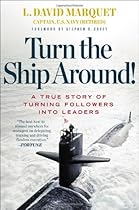A while back, Mike Rother sent around a link to a sketchcast video of a U.S. Navy submarine skipper talking about the culture change aboard his submarine, the USS Santa Fe. I posted and commented on it below, in “Creating an Empowered Team.” If you haven’t watched it, do so now so you have context for the rest of this post.
 Since then, I found other presentations by Capt Marquet (pronounced, I have learned, “mar-kay”), read every post on his blog, then bought and read his book Turn the Ship Around.
Since then, I found other presentations by Capt Marquet (pronounced, I have learned, “mar-kay”), read every post on his blog, then bought and read his book Turn the Ship Around.
His message is compelling, and I have been digesting and integrating it for a couple of months now.
The Empowerment Movement
Back in the late 80’s and early 90’s there was a big push for “empowerment” and the idea of “self directed work teams.”
Supervisors and managers were re-titled as “coaches.”
Work teams were told they were expected to self-organize to accomplish the work at hand.
I suspect this was yet another case of “benchmark and copy” – observing the attributes of high-performance organizations and trying get the same results by duplicating the description. “They have self-directed work teams, so let’s tell our work teams to self-direct.”
In the classic words of Dr Phil… “How’s that workin’ for ya?”
I have worked with, and in, a few organizations with a very bad taste for their past experiments with “empowerment.”
The Difference between “Involved” and “Committed” Leadership
Obviously some organizations have succeeded at creating work environments where work teams know what has to be done and do it. If that weren’t the case, there wouldn’t have been anyone to benchmark and copy.
Capt Marquet’s book gives us a first experience account of a leader who resolved to change the climate of his organization. Admittedly, he did so out of perceived necessity. (Read the book to get the full story!)
Today, though, when leaders say they are “committed” they usually mean they are willing to fund an effort, allow someone else to carry it out, get updates, and give encouragement. That might work for starting a subsidiary, but it doesn’t work for changing “how things get done.”
What we are talking about here is developing the competence and capability of the organization, step by step, individual by individual, as the primary daily work of leadership.
Capt Marquet describes his struggles, setbacks, how hard it was at times, and the long-term reward of his efforts – unprecedented promotion rates or personal successes among his former officers and crew in the 10 years following his time in command. His primary role was developing people. They happened to be the crew of a nuclear powered submarine.
Over the next few posts, I am going to explore the correlation between David Marquet’s leadership development model and Toyota Kata. Stay tuned.
In the meantime, read the book. It’s an easy read and worth your time.
M. Rosenthal,
I’ve been a follower of your blog since 2011. I discovered Toyota Kata in 2010 and could see how it influenced your post when you discovered it yourself and attended the seminar with Mike. I attended myself in august 2011 and i’ve been practicing the improvement kata since. Now that I’m in charge of a support team (Lean) in the healthcare business i starter practicing the coaching kata more formally and my 2014 plan is to get going with toyota kata deployment (120 staff people vs 3700 doctors and employees). I just wanted to inform you that I responded to your suggestion and bougth the book. I’m curently at page 175 and see lots of similarities with Toyota Kata and the context of my organisation. Can’t wait for your following posts.
Best regards,
Philippe